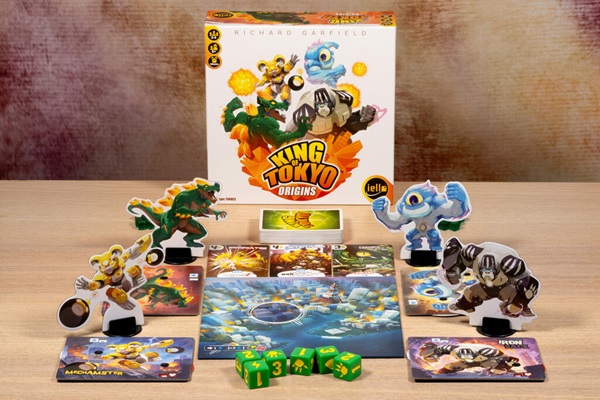Smash, Roar, and Terrorize in King of Tokyo: Origins

Take on the role of terrifying monster wreaking havoc through Tokyo city! Smash, attack, and power-up to become the most fearsome monster of them all.
Published by IELLO, King of Tokyo: Origins is for 2-4 players and is designed to be an entry point into the popular series that began with King of Tokyo. So, how does it do?
Gameplay
Each player chooses a monster and starts the game with ten health. On each turn, the active player takes the six dice and rolls them. He has two rerolls, and can reroll as few or as many of the dice as he wishes. He then resolves the dice results.
Dice can roll a one, two, or three. If a player rolls three of the same number, he earns points equal to that number. Any additional copies of that number he rolls also earn a bonus point. For any hearts a player resolves, he heals for one health point if he is not in Tokyo. For any energy he rolls, he gains one energy cube. Finally, if he resolves any smash symbols, he attacks. If he is in Tokyo, he attacks all other players. If the active player is not in Tokyo, he attacks the player who is in Tokyo. The player or players being attacked lose one health point for each smash symbol being resolved. If a player in Tokyo is attacked, after losing health, he may choose to leave Tokyo.
After resolving the dice, the active player checks to see if there is a monster in Tokyo. If there is not, he must move his monster token into Tokyo. A player earns one point when he enters Tokyo, and earns two points at the start of his turn if he is in Tokyo.
Finally, the active player may use his energy cubes to buy power cards. There is always a display of three power cards. Each card lists how many power cubes a player has to spend in order to purchase it, as well as its ability and if a player gets to keep it in play, or if it is discarded once the ability has been used. As soon as a power card has been bought, a new one is drawn to replace it. A player can buy as many power cards on his turn as he wishes and as he can afford to. He can also spend two power cubes in order to discard all the cards currently in the display and draw new ones to replace it.
If a player ever reaches zero hit points, he is out of the game. The first player to reach 20 points, or the last player left standing, wins the game.

Review
A lot about King of Tokyo: Origins is the same as the original game. It’s a fun theme, it’s got some great push-your-luck decisions, good art, and speedy turns. The power cards offer different strategies to pursue and can mix things up in unexpected ways.
King of Tokyo always has the issue of player elimination, and Origins hasn’t done anything to change this. A player can certainly choose to leave Tokyo as soon as possible, but the game can still swing so quickly between a nice big health buffer and near-dead, and it’s completely possible to not roll the healing you need, so that you can still end up sitting out a hunk of game without having made any particularly poor decisions.
Origins comes packed in a smaller box with fewer components, making it more travel-friendly and available at a lower price point than the original (around $10 less, depending on the retailer). It only supports 2-4 players, as compared to 5-6 players with the original, but this change reduces some of the complexity. Specifically, the rules surrounding Tokyo Bay that were intended for 5-6 players are no longer needed. The power cards also seem a bit simpler and easier to understand, potentially making this game a good choice for families with children or newer gamers.
But the question remains: is Origins really a better place to start than the regular, base game? We always appreciate efforts to streamline games for a casual audience, and this game with its simpler play and lower price point is likely to reach new players, which is always a plus. Everyone's mileage is going to vary, but for us we didn't feel this game offered a big enough difference to replace the original game as our go-to for teaching new players. While King of Tokyo has a lot of expansions and additions, it is still at its core a pretty accessible game, and with the added benefit of more players supported, it remains our preference.
All of that being said, the new monsters have great artwork, and there are new power cards that can be added to the base game, so huge fans of the series can actually find something in this box that might make it worth adding to their collection.
Pros: New monsters, new power cards that can be added into the base game, slightly simpler gameplay for families, lower price point than the original
Cons: Didn’t feel like a particularly better entry point into the series than the original
Disclosure: we received a complimentary review copy of this game.






